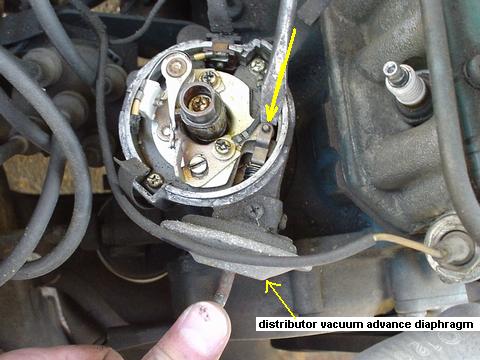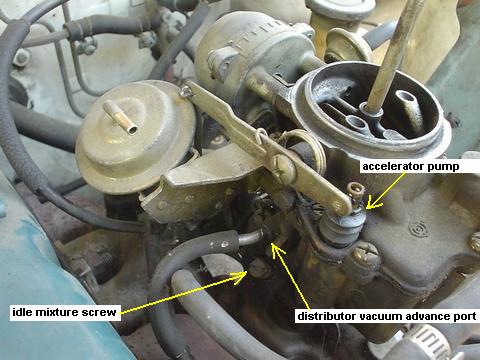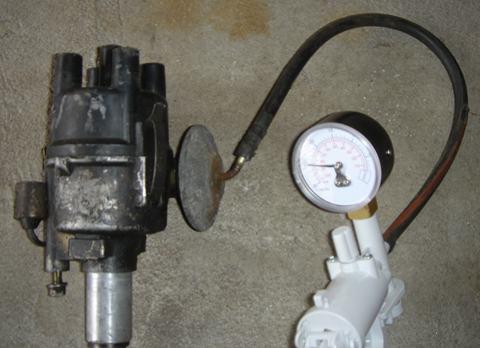| Revision as of 02:49, 6 May 2014 ddgonzal (Talk | contribs) (->Manifold Vacuum) <- Previous diff |
Revision as of 03:00, 6 May 2014 ddgonzal (Talk | contribs) (->Manifold Vacuum) Next diff -> |
||
| Line 47: | Line 47: | ||
| <blockquote>Ported Vacuum” was strictly an early pre-converter crude emissions strategy and nothing more. | <blockquote>Ported Vacuum” was strictly an early pre-converter crude emissions strategy and nothing more. | ||
| - | <br> <br> | + | <br> |
| ... | ... | ||
| - | <br> <br> | + | <br> |
| After 30-plus years of controlling vacuum advance systems with full manifold vacuum ... along came early emission control requirements ... were introduced to try to reduce hydrocarbons and oxides of nitrogen in the exhaust stream | After 30-plus years of controlling vacuum advance systems with full manifold vacuum ... along came early emission control requirements ... were introduced to try to reduce hydrocarbons and oxides of nitrogen in the exhaust stream | ||
| <br> <br> | <br> <br> | ||
| - | - John Hinkley, Chrysler engineer involved in development of vacuum advance | + | - [http://www.corvettemuseum.org/library-archives/hof/hinckley.shtml John Hinckley], GM engineer involved in development of vacuum advance |
| <br>'''Timing And Vacuum Advance 101''' in ''Corvette Enthusiast'' magazine | <br>'''Timing And Vacuum Advance 101''' in ''Corvette Enthusiast'' magazine | ||
| </blockquote> | </blockquote> | ||
Revision as of 03:00, 6 May 2014
Vacuum advance is a spark timing mechanism. It advances the timing under light load, thereby making more power and better fuel economy. It lets the timing go back to normal under heavy loads, thereby preventing detonation (pinking/pinging).
Contents |
Overview
This is a good system that adds both extra performance, better fuel economy, and smoothness to the driving experience.
The only downside is for high-RPM A-series racing engines, where the advance mechanism adds some mechanical instability to the spark timing of the Distributor over 8000 rpm.
Connection
The rubber hose on the Distributor goes straight over the 'vacuum advance port' on the Carburetor. That's it.
Emission controlled vehicles have a Tee in this line for the TCVAS system. This system cuts vacuum under some conditions, lessening performance but improving pollution (less pollution).
Degrees
For a factory stock engine, including 1.5" exhaust this a typical factory advance curve:
Vacuum Advance - part D412-80 for manual transmission

For more details, see Spark Curve
Maintenance
The only maintenance is to periodically make sure the diaphragm is not leaking.
See: Vacuum Leaks
Vacuum Retard
Some newer USA engines (e.g. 1981 B310) are fitted with a vacuum retard diaphragm. This is for emission control reasons, it actually retards the spark timing. This results in improved emissions (less pollution).
Note that this does not hurt performance. It is activated via the Throttle Opener vacuum control line, so only works when Decelerating.
Vacuum Advance - To use or Not?
Yes, use it. It is good. It advances your engine. More spark = more power.
Manifold Vacuum
The stock setup is distributor connected to the carburetor's spark port which works OK.
But it will run slightly better on manifold vacuum. A-series engine runs good with no advance. But will get better fuel economy with it. So connect it to manifold and set timing with it disconnected.
Ported Vacuum” was strictly an early pre-converter crude emissions strategy and nothing more.
...
After 30-plus years of controlling vacuum advance systems with full manifold vacuum ... along came early emission control requirements ... were introduced to try to reduce hydrocarbons and oxides of nitrogen in the exhaust stream
- John Hinckley, GM engineer involved in development of vacuum advance
Timing And Vacuum Advance 101 in Corvette Enthusiast magazine

![[Datsun 1200 encyclopedia]](/wiki/upload/wiki.png)



